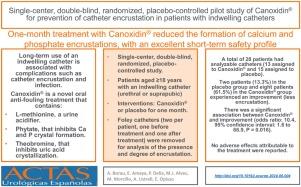Canoxidin® 用于预防留置导管患者导管结壳的单中心、双盲、随机、安慰剂对照试验研究。
引用次数: 0
摘要
导言和目的:长期使用留置导管会导致导管结壳和感染等并发症。Canoxidin® 是一种新型口服治疗药物,含有尿酸化剂和两种结晶抑制剂的组合,有可能预防导管结壳。本研究旨在评估 Canoxidin® 对留置 Foley 导管患者导管结壳的影响:这是一项单中心、双盲、随机、安慰剂对照研究。年龄≥18 岁、留置导尿管(尿道或耻骨上导尿管)的神经泌尿科患者被随机分配接受为期一个月的 Canoxidin® 或安慰剂治疗。每个患者拔出两根导尿管(一根在治疗前,一根在治疗后),以分析是否存在包壳以及包壳的程度:共有 40 名患者参加了随机治疗,其中 28 人的导管可进行分析(13 人被分配使用 Canoxidin®,15 人被分配使用安慰剂)。患者的平均年龄为 51.8 岁,其中 8 人(28.6%)为女性。安慰剂组的两名患者(13.3%)和 Canoxidin® 组的八名患者(61.5%)的病情有所改善(结壳减少)。Canoxidin®与病情改善之间存在明显关联(几率比:10.4,95% 置信区间:1.6 至 66.9,P = 0.016)。结论:Canoxidin®与导管包膜改善之间存在明显关联(几率比:10.4,95% 置信区间:1.6 至 66.9,P = 0.016):结论:在留置福里导管的患者中,导管结壳的总体发生率很高。使用 Canoxidin® 进行为期一个月的治疗可减少这些包壳的形成,而且短期安全性极佳。本文章由计算机程序翻译,如有差异,请以英文原文为准。

Single-center, double-blind, randomized, placebo-controlled pilot study of Canoxidin® for prevention of catheter encrustation in patients with indwelling catheters
Introduction and objectives
Long-term use of an indwelling catheter is associated with complications such as catheter encrustation and infection. Canoxidin® is a novel oral treatment that can potentially prevent catheter encrustation, as it contains a urine acidifier and a combination of two crystallization inhibitors. This study aimed to evaluate the effects of Canoxidin® on catheter encrustation in patients with indwelling Foley catheters.
Patients and methods
This was a single-center, double-blind, randomized, placebo-controlled study. Neuro-urology patients aged ≥18 years with an indwelling catheter (urethral or suprapubic) were randomized to treatment consisting of either Canoxidin® or placebo for one month. Foley catheters (two per patient, one before treatment and one after treatment) were removed for analysis of the presence and degree of encrustation.
Results
A total of 40 patients were enrolled and randomized, 28 of whom had analyzable catheters (13 assigned to Canoxidin® and 15 assigned to placebo). The patients had a mean age of 51.8 years, and eight (28.6%) were female. Two patients (13.3%) in the placebo group and eight patients (61.5%) in the Canoxidin® group experienced an improvement (less encrustation). There was a significant association between Canoxidin® and improvement (odds ratio: 10.4, 95% confidence interval: 1.6 to 66.9, P = 0.016). No adverse effects attributable to the treatment were reported.
Conclusions
The overall rate of catheter encrustation was high among those with indwelling Foley catheters. One-month treatment with Canoxidin® reduced the formation of these encrustations, with an excellent short-term safety profile.
求助全文
通过发布文献求助,成功后即可免费获取论文全文。
去求助

 求助内容:
求助内容: 应助结果提醒方式:
应助结果提醒方式:


